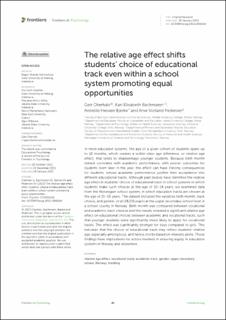The relative age effect shifts students’ choice of educational track even within a school system promoting equal opportunities
| dc.contributor.author | Oterhals, Geir | |
| dc.contributor.author | Bachmann, Kari Elisabeth | |
| dc.contributor.author | Bjerke, Annette Hessen | |
| dc.contributor.author | Pedersen, Arve Vorland | |
| dc.date.accessioned | 2023-03-02T12:29:32Z | |
| dc.date.available | 2023-03-02T12:29:32Z | |
| dc.date.created | 2023-01-10T08:33:17Z | |
| dc.date.issued | 2023 | |
| dc.identifier.citation | Front. Psychol. 2023, 13, 1066264. | en_US |
| dc.identifier.issn | 1664-1078 | |
| dc.identifier.uri | https://hdl.handle.net/11250/3055377 | |
| dc.description.abstract | In most education systems, the age of a given cohort of students spans up to 12 months, which creates a within-class age difference, or relative age effect, that tends to disadvantage younger students. Because birth month indeed correlates with academic performance, with poorer outcomes for students born later in the year, the effect can have lifelong consequences for students, whose academic performance justifies their acceptance into different educational tracks. Although past studies have identified the relative age effect in students’ choice of educational track in school systems in which students make such choices at the age of 10–14 years, we examined data from the Norwegian school system, in which education tracks are chosen at the age of 15–16 years. The dataset included the variables birth month, track choice, and gender, of all 28,231 pupils at the upper secondary school level in a school county in Norway. Birth month was compared between vocational and academic track choices and the results revealed a significant relative age effect on educational choices between academic and vocational tracks, such that younger students were significantly more likely to apply for vocational tracks. The effect was significantly stronger for boys compared to girls. This indicates that the choice of educational track may reflect students’ relative age, especially among boys, and hence, not be based on interests alone. Those findings have implications for actors involved in ensuring equity in education systems in Norway and elsewhere. Keywords: relative age effect, vocational track, academic track, gender, upper secondary school, Norway, tracking | en_US |
| dc.language.iso | eng | en_US |
| dc.relation.uri | https://doi.org/10.3389/fpsyg.2022.1066264 | |
| dc.rights | Navngivelse 4.0 Internasjonal | * |
| dc.rights.uri | http://creativecommons.org/licenses/by/4.0/deed.no | * |
| dc.subject | within-class age difference | en_US |
| dc.subject | relative age effect | en_US |
| dc.subject | occupational choice | en_US |
| dc.subject | yrkesvalg | en_US |
| dc.subject | upper secondary school | en_US |
| dc.subject | videregående skole | en_US |
| dc.subject | relativ alderseffekt | en_US |
| dc.title | The relative age effect shifts students’ choice of educational track even within a school system promoting equal opportunities | en_US |
| dc.title.alternative | The relative age effect shifts students’ choice of educational track even within a school system promoting equal opportunities | en_US |
| dc.type | Peer reviewed | en_US |
| dc.type | Journal article | en_US |
| dc.description.version | publishedVersion | en_US |
| dc.source.volume | 13 | en_US |
| dc.source.journal | Frontiers in Psychology | en_US |
| dc.identifier.doi | 10.3389/fpsyg.2022.1066264 | |
| dc.identifier.cristin | 2103703 | |
| dc.source.articlenumber | 1066264 | en_US |
| cristin.ispublished | true | |
| cristin.fulltext | original | |
| cristin.qualitycode | 1 |

